结肠镜的并发症
消化内镜操作常见并发症的预防与处理措施
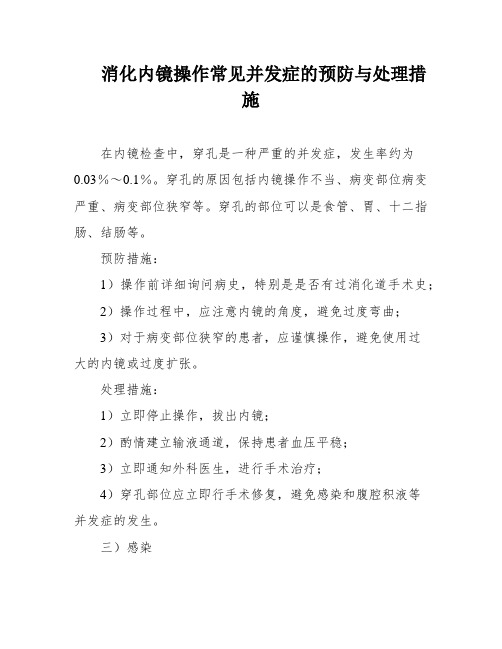
消化内镜操作常见并发症的预防与处理措施在内镜检查中,穿孔是一种严重的并发症,发生率约为0.03%~0.1%。
穿孔的原因包括内镜操作不当、病变部位病变严重、病变部位狭窄等。
穿孔的部位可以是食管、胃、十二指肠、结肠等。
预防措施:1)操作前详细询问病史,特别是是否有过消化道手术史;2)操作过程中,应注意内镜的角度,避免过度弯曲;3)对于病变部位狭窄的患者,应谨慎操作,避免使用过大的内镜或过度扩张。
处理措施:1)立即停止操作,拔出内镜;2)酌情建立输液通道,保持患者血压平稳;3)立即通知外科医生,进行手术治疗;4)穿孔部位应立即行手术修复,避免感染和腹腔积液等并发症的发生。
三)感染内镜检查过程中,由于操作不当或清洗不彻底等原因,可能会引起感染。
感染的部位可以是检查部位、周围组织或全身性感染。
预防措施:1)操作前洗手消毒;2)内镜清洗消毒彻底;3)使用无菌器械;4)穿戴手套、口罩等个人防护用品。
处理措施:1)根据感染部位和病情轻重选择适当的抗生素治疗;2)加强患者的营养支持,维持水电解质平衡;3)如有明显全身感染症状,应及时转诊至感染科或XXX 治疗。
三、结论内镜操作常见并发症的预防和处理措施非常重要,医生应当认真执行操作规程,严格执行操作流程,提高操作技术水平,避免操作失误和疏忽。
同时,医生还应当及时处理并发症,维护良好的医患关系,确保患者得到及时有效的治疗。
上消化道内镜检查中,穿孔发生率为0.02%~0.22%。
食管穿孔是最常见的穿孔部位,其中颈段食管易穿孔多源于解剖学因素,而胸段和腹段食管穿孔的原因则多以器质性病变为主。
食管下1/3的狭窄是与食管穿孔最常见的病变相关联的。
胃或十二指肠穿孔非常少见,但是剧烈干呕、内镜操作时注气过多及溃疡部位的活检等因素都可能导致胃十二指肠溃疡穿孔。
结肠镜检查相关的穿孔发生率在%~0.9%之间,最常见的部位是直肠-乙状结肠和乙状结肠-降结肠交界处。
为了预防穿孔的发生,我们需要采取以下措施:(1)填写知情同意书;(2)胃镜检查进咽部时,直视下进镜,动作轻柔,不暴力进镜;(3)结肠镜检查时要求循腔进镜,少滑镜,解袢时动作轻柔,观察病人反应,并及时停止操作;(4)对于经验不足的操作者,或者对于存在手术史、肠粘连、重度溃疡性结肠炎等情况的患者,应及时请经验丰富的上级医师操作。
结肠镜检查致气胸,纵隔气肿及皮下气肿1例及文献总结
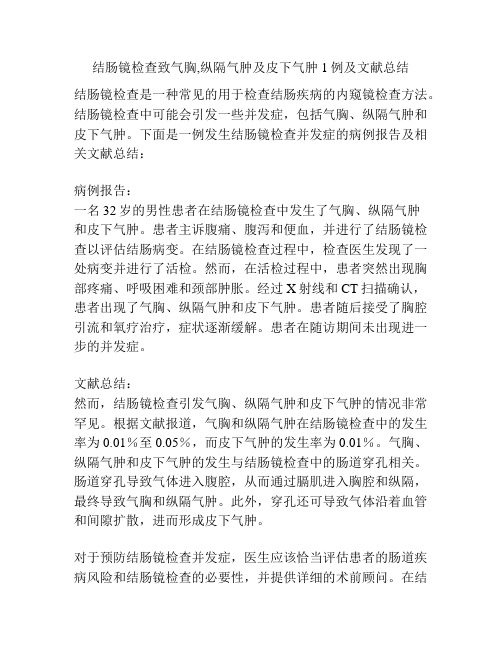
结肠镜检查致气胸,纵隔气肿及皮下气肿1例及文献总结结肠镜检查是一种常见的用于检查结肠疾病的内窥镜检查方法。
结肠镜检查中可能会引发一些并发症,包括气胸、纵隔气肿和皮下气肿。
下面是一例发生结肠镜检查并发症的病例报告及相关文献总结:病例报告:一名32岁的男性患者在结肠镜检查中发生了气胸、纵隔气肿和皮下气肿。
患者主诉腹痛、腹泻和便血,并进行了结肠镜检查以评估结肠病变。
在结肠镜检查过程中,检查医生发现了一处病变并进行了活检。
然而,在活检过程中,患者突然出现胸部疼痛、呼吸困难和颈部肿胀。
经过X射线和CT扫描确认,患者出现了气胸、纵隔气肿和皮下气肿。
患者随后接受了胸腔引流和氧疗治疗,症状逐渐缓解。
患者在随访期间未出现进一步的并发症。
文献总结:然而,结肠镜检查引发气胸、纵隔气肿和皮下气肿的情况非常罕见。
根据文献报道,气胸和纵隔气肿在结肠镜检查中的发生率为0.01%至0.05%,而皮下气肿的发生率为0.01%。
气胸、纵隔气肿和皮下气肿的发生与结肠镜检查中的肠道穿孔相关。
肠道穿孔导致气体进入腹腔,从而通过膈肌进入胸腔和纵隔,最终导致气胸和纵隔气肿。
此外,穿孔还可导致气体沿着血管和间隙扩散,进而形成皮下气肿。
对于预防结肠镜检查并发症,医生应该恰当评估患者的肠道疾病风险和结肠镜检查的必要性,并提供详细的术前顾问。
在结肠镜检查中,医生应该注意检查过程中的异常表现,如突然的剧烈腹痛、无法马上缓解的肠道充气阻力等,这些可能表明肠道穿孔的发生。
一旦发现可能的穿孔,医生应立即停止检查并采取相应措施,如胸腔引流、气胸自闭合、抗生素预防等。
总结来说,结肠镜检查引发气胸、纵隔气肿和皮下气肿的情况罕见,但仍需医生和患者注意相关的并发症风险以及检查过程中的异常表现。
早期发现并及时处理肠道穿孔是预防并发症的关键。
结肠镜可行性报告
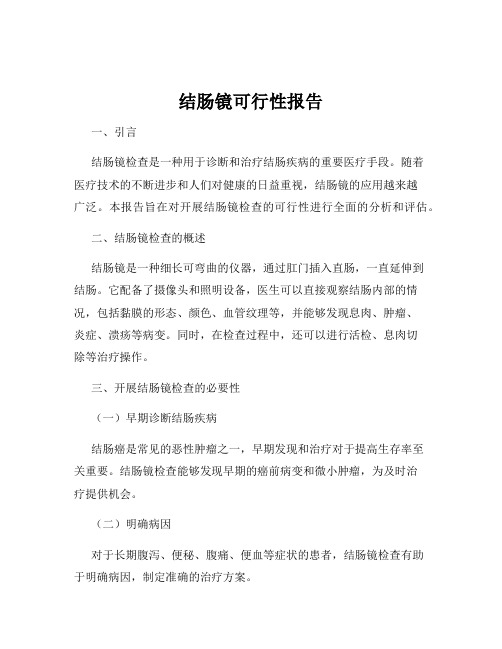
结肠镜可行性报告一、引言结肠镜检查是一种用于诊断和治疗结肠疾病的重要医疗手段。
随着医疗技术的不断进步和人们对健康的日益重视,结肠镜的应用越来越广泛。
本报告旨在对开展结肠镜检查的可行性进行全面的分析和评估。
二、结肠镜检查的概述结肠镜是一种细长可弯曲的仪器,通过肛门插入直肠,一直延伸到结肠。
它配备了摄像头和照明设备,医生可以直接观察结肠内部的情况,包括黏膜的形态、颜色、血管纹理等,并能够发现息肉、肿瘤、炎症、溃疡等病变。
同时,在检查过程中,还可以进行活检、息肉切除等治疗操作。
三、开展结肠镜检查的必要性(一)早期诊断结肠疾病结肠癌是常见的恶性肿瘤之一,早期发现和治疗对于提高生存率至关重要。
结肠镜检查能够发现早期的癌前病变和微小肿瘤,为及时治疗提供机会。
(二)明确病因对于长期腹泻、便秘、腹痛、便血等症状的患者,结肠镜检查有助于明确病因,制定准确的治疗方案。
(三)监测治疗效果对于已经确诊的结肠疾病患者,如溃疡性结肠炎、克罗恩病等,结肠镜检查可以监测疾病的发展和治疗效果。
四、技术可行性(一)设备与技术成熟目前,结肠镜设备不断更新换代,图像清晰度高,操作灵活性好。
同时,医生经过专业培训,具备丰富的操作经验,能够熟练完成检查和治疗。
(二)麻醉支持为了减轻患者的痛苦,可在检查过程中采用无痛麻醉技术,使患者在睡眠状态下完成检查,提高患者的依从性。
(三)并发症的预防和处理虽然结肠镜检查存在一定的风险,如出血、穿孔等,但通过严格的术前评估、规范的操作和及时的处理,并发症的发生率可以控制在较低水平。
五、市场需求分析(一)人口老龄化随着人口老龄化的加剧,结肠疾病的发病率呈上升趋势,对结肠镜检查的需求也相应增加。
(二)健康意识提高人们对健康的重视程度不断提高,愿意主动接受体检和筛查,以早期发现潜在的疾病。
(三)医疗保障覆盖医保政策的不断完善,使得更多的患者能够承担结肠镜检查的费用,进一步促进了市场需求的增长。
六、经济可行性(一)成本投入开展结肠镜检查需要购置设备、培训人员、建设检查室等,初期投入较大。
2分钟完成结肠镜绝招
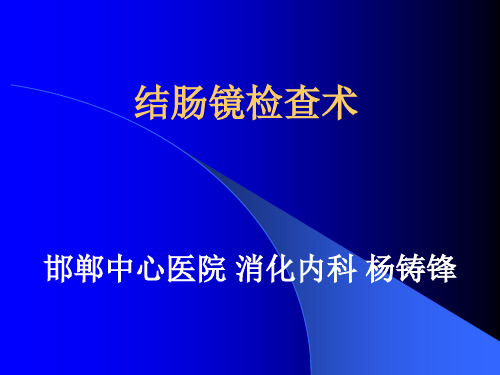
变换体位与手法推压
精髓—寻腔进 镜,不进则退
寻腔 –必须认识肠腔的特点及走向。找腔的要点: 进进退退、注气调钮、旋转镜身。 跟腔 –准确地跟腔,一是为了不失插镜的时机, 二是为了加快进镜的速度。要熟练辨认肠 腔的方向,迅速的调节角度钮及旋转镜身。 滑进 –在不见肠腔的情况下镜头贴在肠壁上滑向 深部肠腔。但要见肠黏膜滑动,而手中阻 力不大。有一定危险性。
吸引
–吸引减少肠腔的气体,肠管向肛侧收缩,
形成相对插入。通过吸气可以使锐角变为 钝角。
–应始终送气不过量。操作不顺利时,多用
吸气和退镜。过度充气寻腔往往适得其反。
单人法的基本技术与技巧
拐弯时取最短路径 透明帽辅助
单人法的基本技术与技巧
变换体位与手法推压 –变换体位利用重力改变肠管的走向。 –一般规律:左侧卧位是基本体位。 到达脾曲之前-左侧卧位, 脾曲至横结肠中央-右侧卧位, 横结肠中央至升结肠-左侧卧位, 升结肠末端至盲肠-左侧或仰卧位。 –小技巧,必要时,助手按压腹部。
精髓--寻腔进镜,不进则退
拉镜 –使肠管像手风琴箱样皱缩在镜身上。要 领:越过弯角,使镜头保持一定的角度, 缓慢退出镜身,视野可能前进或不动, 直到视野后退停止退镜。 防襻 –当镜身在乙状结肠及横结肠成襻时,需 手法防襻。乙状结肠:压脐左下方触及 腹后壁。横结肠:顶住横结肠下垂角。
必须掌握的基本功
前端作出迅速反应。 不进则退——非常重要
–进镜有阻力或不通畅,可暂时退
镜。
插镜的基本方法
少充气,多吸引 –肠腔保持恰当的充气量是成功的保障。 寻腔进镜结合滑镜 –寻腔进镜最安全,但有时需采用滑镜。 去弯取直 –借助手法或器械使镜身取直。 急弯变慢弯,锐角变钝角 –这是最基本的原则。
结肠镜检查护理常规及流程

结肠镜检查护理常规及流程英文回答:Colonoscopy Care Protocol and Procedure.Pre-Procedure:Fasting: Patients are required to fast for 8-12 hours prior to the procedure to clear their bowels.Bowel Preparation: The patient must follow a specific bowel preparation regimen, such as taking laxatives or enemas, to clean their colon.Medications: Patients should inform their doctor about any medications they are taking, as some may need to be adjusted or discontinued before the colonoscopy.Consent: The patient must provide informed consent for the procedure, understanding the risks and benefitsinvolved.Procedure:Patient Positioning: The patient lies on their left side on the examination table.Sedation: Most colonoscopies are performed under sedation, which helps the patient relax and minimize discomfort.Insertion: The colonoscope is inserted into the rectum and advanced through the colon.Examination: The doctor uses the colonoscope to examine the lining of the colon for any abnormalities, such as polyps or inflammation.Biopsy: If any suspicious areas are identified, the doctor may take biopsies (small samples of tissue) for further examination.Removal of Polyps: If any polyps are found, the doctor may remove them using special instruments.Post-Procedure:Recovery: The patient is taken to the recovery roomfor monitoring until the sedative wears off.Discharge: Most patients are discharged home the same day after the procedure.Follow-Up: The doctor will provide follow-up instructions, such as managing any discomfort and scheduling a follow-up appointment.Risks and Complications:While colonoscopies are generally safe, potential risks and complications include:Bleeding from the biopsy or polyp removal site.Perforation (a tear in the colon)。
结肠镜检查并发肠穿孔临床分析
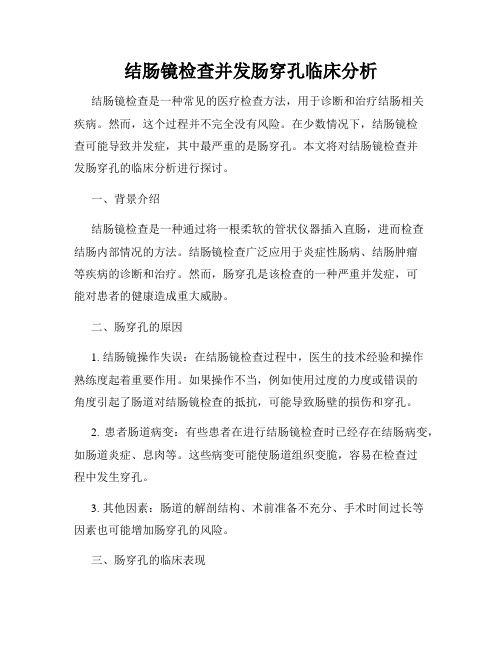
结肠镜检查并发肠穿孔临床分析结肠镜检查是一种常见的医疗检查方法,用于诊断和治疗结肠相关疾病。
然而,这个过程并不完全没有风险。
在少数情况下,结肠镜检查可能导致并发症,其中最严重的是肠穿孔。
本文将对结肠镜检查并发肠穿孔的临床分析进行探讨。
一、背景介绍结肠镜检查是一种通过将一根柔软的管状仪器插入直肠,进而检查结肠内部情况的方法。
结肠镜检查广泛应用于炎症性肠病、结肠肿瘤等疾病的诊断和治疗。
然而,肠穿孔是该检查的一种严重并发症,可能对患者的健康造成重大威胁。
二、肠穿孔的原因1. 结肠镜操作失误:在结肠镜检查过程中,医生的技术经验和操作熟练度起着重要作用。
如果操作不当,例如使用过度的力度或错误的角度引起了肠道对结肠镜检查的抵抗,可能导致肠壁的损伤和穿孔。
2. 患者肠道病变:有些患者在进行结肠镜检查时已经存在结肠病变,如肠道炎症、息肉等。
这些病变可能使肠道组织变脆,容易在检查过程中发生穿孔。
3. 其他因素:肠道的解剖结构、术前准备不充分、手术时间过长等因素也可能增加肠穿孔的风险。
三、肠穿孔的临床表现1. 术后腹痛:患者在结肠镜检查后可能出现腹痛,疼痛部位通常在腹部,疼痛强度可因穿孔的严重程度而不同。
2. 腹膜刺激征:严重肠穿孔可能导致腹膜刺激征,包括腹膜炎症反应、腹胀、压痛等症状。
3. 腹部灶性恶心、呕吐:肠穿孔引起的腹腔感染可能导致恶心、呕吐等胃肠道症状。
四、肠穿孔的处理方法一旦发现肠穿孔,医生应立即停止结肠镜检查,并采取紧急处理措施。
常见的处理方法包括:1. 立即进行手术:对于严重的肠穿孔,手术是最常用的治疗方法。
手术旨在修复穿孔部位,恢复肠道完整性,并清除腹腔中的感染物。
2. 抗感染治疗:肠穿孔可导致腹腔感染,因此抗感染治疗在处理过程中也是必不可少的一环。
3. 营养支持:肠穿孔患者常需要长时间禁食,因此,提供适当的营养支持对于患者的康复至关重要。
五、预防肠穿孔的措施为了减少结肠镜检查引起的并发症,特别是肠穿孔,以下措施应予以重视:1. 医生培训:医生需要接受严格的结肠镜操作培训,提高操作技术和风险意识,以减少潜在的操作失误。
2024结直肠镜检查六大错误总结
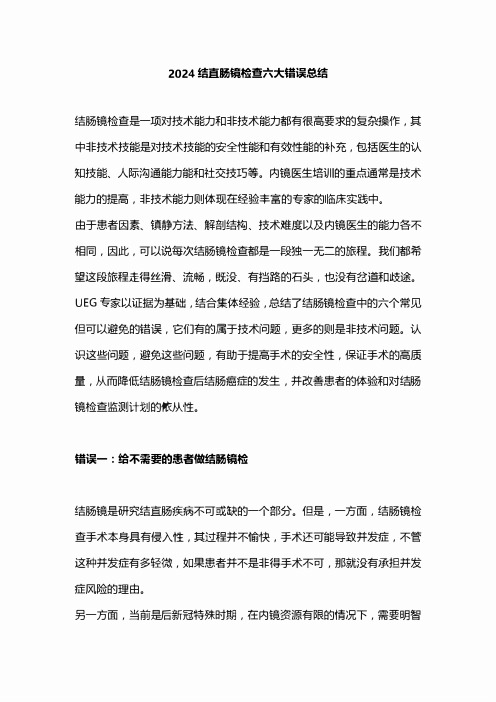
2024结直肠镜检查六大错误总结结肠镜检查是—项对技术能力和非技术能力都有很高要求的复杂操作,其中非技术技能是对技术技能的安全性能和有效性能的补充,包括医生的认知技能、人际沟通能力能和社交技巧等。
内镜医生培训的重点通常是技术能力的提高,非技术能力则体现在经验丰富的专家的临床实践中。
由千患者因素、镇静方法、解剖结构、技术难度以及内镜医生的能力各不相同,因此,可以说每次结肠镜检查都是—段独—无二的旅程。
我们都希望这段旅程走得丝滑、流畅,既没、有挡路的石头,也没有岔道和歧途。
UEG专家以证据为基础,结合集体经验,总结了结肠镜检查中的六个常见但可以避免的错误,它们有的属千技术问题,更多的则是非技术问题。
认识这些问题,避免这些问题,有助于提高手术的安全性,保证手术的高质量,从而降低结肠镜检查后结肠癌症的发生,并改善患者的体验和对结肠镜检查监测计划的依从性。
错误一:给不需要的患者做结肠镜检结肠镜是研究结直肠疾病不可或缺的—个部分。
但是,—方面,结肠镜检查手术本身具有侵入性,其过程并不愉快,手术还可能导致并发症,不管这种并发症有多轻微,如果患者并不是非得手术不可,那就没有承担并发症风险的理由。
另—方面,当前是后新冠特殊时期,在内镜资源有限的情况下,需要明智地选择患者,才能尽快完成疫情期间因各种原因积压的内镜手术。
因此,我们需要在正确的时间,选择正确的患者,有选择地进行结肠镜检查。
表1内镜医生选择结肠镜检查患者时考虑的问题合适的适应证适应证和审查车专诊的完整性多学科决策/途径共病患者因素运动耐受性ASA分级进行合适的准备肠道准备患者顺应性粪便检查(粪钙卫蛋白,潜血试验)其他检查方法CT结肠造影可曲式乙状结肠镜检查医生在转诊患者前,应了解结肠镜的适应证,并且与内镜医生沟通,了解其他检查方法的使用情况,例如CT结肠造影、柔性乙状结肠镜检查等。
这个过程中,有相关知识储备、经验丰富(最好是内镜检查相关)的护士将提供重要的帮助。
电子结肠镜检查的常见并发症及护理
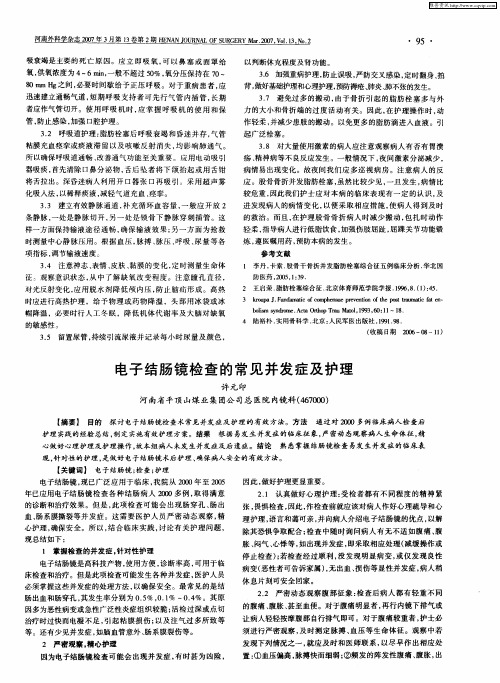
1 李丹 , 卡索 . 股骨干骨折并发脂肪栓塞综合征五例 l床分析 . 临 华北 国
防医药 ,05 13 . 20 ,:9
项 指标 , 调节输液速度 。 3 4 注意神志 、 . 表情 、 皮肤 、 黏膜的变 化 , 时测量生 命体 定 征。观 察意识状 态 , 中了解缺 氧改 变程度 。注 意瞳 孔直 径 , 从
b l m y d o oi s n rme. t s AcaOr o r uMao . 9 3. 0: 1~l t pT a h t1 1 9 6 1 8.
时应进行高热护理 ,给予 物理 或药物 降温 ,头 部用 冰袋或 冰 帽降温 ,必要时行 人工冬 眠 ,降低 机体 代谢率 及大 脑对缺 氧
迅速建立通畅气道 , 短期 呼 吸支持 者可先行 气管 内插 管 , 长期
者应作气管切开 。使 用 呼吸 机 时 , 掌握 呼 吸机 的 使用 和 保 应 管, 防止感染 , 加强 口腔护理 。 32 呼吸道护 理 : . 脂肪栓塞后 呼吸衰竭 和 昏迷并 存 , 管 气 粘膜充血痉挛或痰液 滞 留以及咳 嗽反射 消失 , 影响肺 通气 。 均
因此 , 做好护理更显重要 。
21 认真做好 心理护 理 : . 受检 者都有不 同程 度 的精神 紧
张, 畏惧检查 , 因此 , 作检查前就应该对病人作 好心理疏导和 心 理护 理 , 语言和蔼可亲 , 向病人介绍 电子结肠镜 的优点 , 并 以解 除其恐惧争取配合 ; 查 中随 时询 问病 人 有无不适 如腹 痛 、 检 腹 胀、 闷气 、 心悸等 , 出现并发症 , 如 即采取相 应处理 ( 减缓操作或 停止检查 )若检查 经过顺 利 , ; 没发现 明显病 变 , 仅发 现 良性 或
结肠镜检查轻微不良事件危险因素及预防
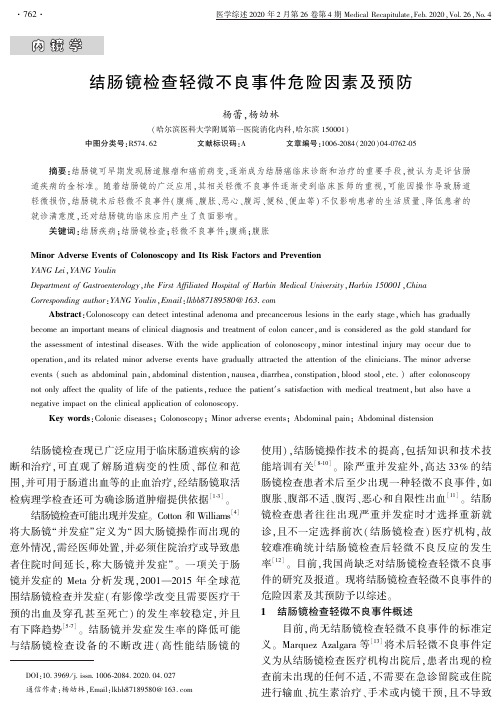
结肠镜检查轻微不良事件危险因素及预防杨蕾ꎬ杨幼林(哈尔滨医科大学附属第一医院消化内科ꎬ哈尔滨150001)㊀㊀DOI:10 3969/j issn 1006 ̄2084 2020 04 027通信作者:杨幼林ꎬEmail:lkbb87189580@163.com中图分类号:R574.62㊀㊀㊀㊀㊀文献标识码:A㊀㊀㊀㊀㊀文章编号:1006 ̄2084(2020)04 ̄0762 ̄05㊀㊀摘要:结肠镜可早期发现肠道腺瘤和癌前病变ꎬ逐渐成为结肠癌临床诊断和治疗的重要手段ꎬ被认为是评估肠道疾病的金标准ꎮ随着结肠镜的广泛应用ꎬ其相关轻微不良事件逐渐受到临床医师的重视ꎬ可能因操作导致肠道轻微损伤ꎬ结肠镜术后轻微不良事件(腹痛㊁腹胀㊁恶心㊁腹泻㊁便秘㊁便血等)不仅影响患者的生活质量㊁降低患者的就诊满意度ꎬ还对结肠镜的临床应用产生了负面影响ꎮ关键词:结肠疾病ꎻ结肠镜检查ꎻ轻微不良事件ꎻ腹痛ꎻ腹胀MinorAdverseEventsofColonoscopyandItsRiskFactorsandPreventionYANGLeiꎬYANGYoulinDepartmentofGastroenterologyꎬtheFirstAffiliatedHospitalofHarbinMedicalUniversityꎬHarbin150001ꎬChinaCorrespondingauthor:YANGYoulinꎬEmail:lkbb87189580@163.comAbstract:Colonoscopycandetectintestinaladenomaandprecancerouslesionsintheearlystageꎬwhichhasgraduallybecomeanimportantmeansofclinicaldiagnosisandtreatmentofcoloncancerꎬandisconsideredasthegoldstandardfortheassessmentofintestinaldiseases.Withthewideapplicationofcolonoscopyꎬminorintestinalinjurymayoccurduetooperationꎬanditsrelatedminoradverseeventshavegraduallyattractedtheattentionoftheclinicians.Theminoradverseevents(suchasabdominalpainꎬabdominaldistentionꎬnauseaꎬdiarrheaꎬconstipationꎬbloodstoolꎬetc.)aftercolonoscopynotonlyaffectthequalityoflifeofthepatientsꎬreducethepatientᶄssatisfactionwithmedicaltreatmentꎬbutalsohaveanegativeimpactontheclinicalapplicationofcolonoscopy.Keywords:ColonicdiseasesꎻColonoscopyꎻMinoradverseeventsꎻAbdominalpainꎻAbdominaldistension㊀㊀结肠镜检查现已广泛应用于临床肠道疾病的诊断和治疗ꎬ可直观了解肠道病变的性质㊁部位和范围ꎬ并可用于肠道出血等的止血治疗ꎬ经结肠镜取活检病理学检查还可为确诊肠道肿瘤提供依据[1 ̄3]ꎮ结肠镜检查可能出现并发症ꎮCotton和Williams[4]将大肠镜 并发症 定义为 因大肠镜操作而出现的意外情况ꎬ需经医师处置ꎬ并必须住院治疗或导致患者住院时间延长ꎬ称大肠镜并发症 ꎮ一项关于肠镜并发症的Meta分析发现ꎬ2001 2015年全球范围结肠镜检查并发症(有影像学改变且需要医疗干预的出血及穿孔甚至死亡)的发生率较稳定ꎬ并且有下降趋势[5 ̄7]ꎮ结肠镜并发症发生率的降低可能与结肠镜检查设备的不断改进(高性能结肠镜的使用)ꎬ结肠镜操作技术的提高ꎬ包括知识和技术技能培训有关[8 ̄10]ꎮ除严重并发症外ꎬ高达33%的结肠镜检查患者术后至少出现一种轻微不良事件ꎬ如腹胀㊁腹部不适㊁腹泻㊁恶心和自限性出血[11]ꎮ结肠镜检查患者往往出现严重并发症时才选择重新就诊ꎬ且不一定选择前次(结肠镜检查)医疗机构ꎬ故较难准确统计结肠镜检查后轻微不良反应的发生率[12]ꎮ目前ꎬ我国尚缺乏对结肠镜检查轻微不良事件的研究及报道ꎮ现将结肠镜检查轻微不良事件的危险因素及其预防予以综述ꎮ1㊀结肠镜检查轻微不良事件概述目前ꎬ尚无结肠镜检查轻微不良事件的标准定义ꎮMarquezAzalgara等[13]将术后轻微不良事件定义为从结肠镜检查医疗机构出院后ꎬ患者出现的检查前未出现的任何不适ꎬ不需要在急诊留院或住院进行输血㊁抗生素治疗㊁手术或内镜干预ꎬ且不导致患者死亡ꎮ结肠镜检查轻微不良事件所引起的症状与结肠镜检查相关ꎬ且症状具有自限性ꎬ一般不需要住院ꎬ但所导致的机体不适可能影响患者接受结肠镜筛查的意愿以及结肠镜检查的满意度ꎬ还可影响其未来接受结肠镜筛查的意愿[14]ꎮ结肠镜轻微不良事件的症状较多ꎬ其中以腹痛和腹胀为主ꎮKo等[15]对结肠镜筛查无症状人群的调查显示ꎬ1/3受试者出现轻微并发症ꎬ其中以自限性腹胀和腹痛最常见ꎬ且大部分症状出现在检查后2d内ꎬ随后症状自行消失ꎬ表明该症状与结肠镜检查有关ꎬ而与检查前存在的功能性肠病无关ꎻ此外ꎬ还有部分受试者出现了不需要医疗处理的便血㊁发热㊁恶心㊁腹泻或便秘ꎮMarquezAzalgara等[13]对结肠镜检查患者进行随访发现ꎬ结肠镜检查后ꎬ患者通常会出现轻微不良事件ꎬ最常见的症状仍为腹痛和腹胀ꎬ常发生在结肠镜检查后48h内ꎬ且几乎全部发生于检查结束后的2周内ꎬ明显超出了检查导致的气体存留时间ꎬ故推测ꎬ该腹痛可能与手术过程中施加于结肠的压力和牵引力引起的轻微软组织创伤有关ꎬ且在大多数情况下ꎬ此创伤可能仅限于结肠壁和邻近肠系膜ꎮ此外ꎬ不同研究的结肠镜轻微不良事件发生率的差异较大ꎬ结肠镜检查后2㊁7㊁14㊁30d的轻微不良事件发生率分别为25.1%[14]㊁34%[15]㊁10%~33%[13 ̄14]㊁3%~29%[16 ̄19]ꎬ导致不同研究结论差异较大的原因可能与试验人群㊁随访时间㊁轻微并发症判断标准以及结肠镜检查无关症状的排除标准不同有关ꎮ此外ꎬ可能将涉及门诊或急诊(未留观)访视的轻微不适以及一些患者无法管理的医疗就诊行为列为严重不良事件ꎬ导致低估了轻微不良事件的发生率[20]ꎮ还需要注意ꎬ结肠镜检查7d后出现的不适症状可能与结肠镜检查无关ꎬ应防止由此导致对轻微不良事件发生率的高估ꎮ2㊀结肠镜检查轻微不良事件的危险因素结肠镜检查轻微不良事件的危险因素主要包括患者的年龄和性别㊁结肠镜检查的持续时间㊁受检者类型㊁合并症㊁美国麻醉医师协会分级>Ⅳ级ꎻ尚有争议的危险因素有镇静麻醉药物的剂量(如咪达唑仑)以及有创操作(如息肉切除术)ꎮ2.1㊀患者年龄㊁性别和合并症㊀结肠镜检查时ꎬ老年患者[16 ̄17]㊁女性患者[8ꎬ14]常出现轻微不良事件ꎮ主要原因为①女性盆腔较大ꎬ肠管在腹腔和盆腔的游离度较大ꎬ导致结肠镜进镜时肠管易结袢ꎻ②女性腹壁肌肉较薄弱ꎬ对结肠镜约束小ꎬ内镜亦容易出现结袢ꎻ③随着患者年龄增大ꎬ腹壁肌肉变薄松弛㊁肌力减弱ꎬ对结肠镜约束力小ꎬ进镜时内镜容易结袢ꎮ因此ꎬ老年及女性患者行结肠镜检查时进镜较困难ꎬ在结肠镜检查时及检查后通常会感到更多不适ꎬ且更易出现轻微和严重不良事件[15ꎬ21]ꎮ有研究发现ꎬ伴肠外合并症结肠镜检查患者较易发生结肠镜检查轻微不良事件[17]ꎮ2.2㊀结肠镜检查的持续时间㊀结肠镜检查时间较长易导致轻微不良事件[15]ꎮ由于结肠解剖结构复杂ꎬ患者的结肠镜检查时间较长ꎬ在结肠镜检查过程中术者操作㊁患者体位变化㊁腹腔充气量以及腹部施加的压力均可能增加轻微不良事件的发生风险ꎬ易出现检查后腹痛或腹胀ꎮ此外ꎬ可能还与结肠镜检查持续时间较长患者镇静药物使用量和其他操作更多有关ꎬ且肠道准备不良患者可能需要更长时间的结肠镜检查ꎬ且可能需要更多的腹腔充气量等操作ꎮ2.3㊀受检者类型㊀与无肠道疾病或有腹腔和盆腔手术史健康体检筛查者相比ꎬ有肠道疾病和肠道手术史患者的轻微不良事件发生率更高[14]ꎮ腹腔和盆腔手术引起的腹膜炎症往往导致腹腔粘连和肠道损伤ꎬ而肠道肿瘤患者易出现肠腔狭窄ꎬ此类患者结肠镜检查时ꎬ对操作者技术的要求更高ꎬ且检查时间更长ꎬ可能进一步加重原有的腹膜和肠道损伤ꎬ故轻微不良事件的发生率明显升高ꎮ2.4㊀麻醉分级㊀麻醉分级具有严格的标准ꎬ其是根据患者全身情况㊁手术分级(类)㊁年龄进行综合分级ꎮ在有效监测和管理下ꎬ麻醉分级与手术风险有关ꎮ美国麻醉医师协会分级的身体状况分类是衡量患者围手术期发病率和死亡率的预测指标ꎬ其中ꎬⅠ级:实施麻醉或手术风险小ꎻⅡ级:实施麻醉或手术有一定的风险ꎻⅢ级:实施麻醉和手术有较大的风险ꎻⅣ级:实施麻醉和手术有很大的风险[16ꎬ22]ꎮ患严重基础疾病ꎬ且器官代偿不全患者结肠镜检查术后更易出现轻微不良事件ꎮ2.5㊀镇静麻醉药物的剂量㊀在结肠镜检查过程中ꎬ使用镇静剂或麻醉药物对减轻患者检查过程中的不适感十分有效ꎬ但其可影响轻微不良事件的发生ꎮBini等[17]研究显示ꎬ较高剂量咪达唑仑与轻微不良事件的发生相关ꎮBaudet等[16]发现ꎬ31%的结肠镜检查患者(25%镇静患者ꎬ52%非镇静患者)出现结肠镜检查术后早期轻微不良事件ꎻ23%的结肠镜检查患者(16%镇静患者ꎬ51%非镇静患者)出现晚期轻微轻微不良事件ꎬ可见ꎬ与非镇静患者相比ꎬ镇静患者的轻微不良事件发生率更低ꎮ以上研究结论的差异ꎬ一方面可能与镇静剂的使用降低了患者的焦虑和肌肉紧张ꎬ提高了医患合作程度ꎬ有助于术者操作有关ꎻ另一方面ꎬ镇静前评估患者基本状态筛除了高危患者ꎬ与研究患者自行选择是否镇静存在偏差ꎮ目前ꎬ我国尚无关于镇静麻醉药物对结肠镜检查轻微不良事件影响的研究ꎬ对其进一步的研究将有助于降低患者术后轻微不良事件发生率ꎮ2.6㊀结肠息肉㊀结肠镜息肉切除术患者ꎬ尤其是行电灼术息肉切除术患者的结肠镜检查术后严重并发症的风险显著升高[23]ꎮKo等[15]的研究显示ꎬ肠道息肉㊁肿块以及憩室病与轻微不良事件的发生无关ꎬ但结肠镜息肉切除术患者的结肠镜检查时间增加ꎻ圈套息肉切除术易导致轻微不良事件ꎬ但未统计患者术前的所有轻微腹部症状ꎬ可能导致对术后轻微不良事件发生率的高估ꎮPark等[24]的研究统计ꎬ结肠息肉切除术后第7天轻微不良事件的发生率为20.9%ꎬ然而ꎬ当轻微症状局限于结肠息肉切除术后新发生并发症时ꎬ术后7d和30d的累积发病率分别为11.7%和11.9%ꎬ最常见的症状是腹痛ꎬ大多数情况其严重程度较轻ꎬ一般持续4dꎻ该研究还发现ꎬ息肉相关因素(如息肉大小ꎬ数量或位置)与轻微不良事件无明显关系ꎬ较Ko等[23]统计的2010年轻微不良事件发生率降低ꎬ可能与比较准确地排除了患者原有症状(有部分患者未报告检查前的腹部症状)以及某些患者的轻微不适症状(患者主观认为是息肉切除术后的正常反应)未向内镜医师反应有关ꎮ关于息肉切除及其切除方式与轻微不良事件的关系尚需进一步研究ꎮ2.7㊀其他因素㊀结肠镜检查轻微不良事件的其他预测危险因素为实习内镜医师㊁合并胃镜检查㊁服用华法林药物史㊁肠镜检查季节等ꎮ相关研究发现ꎬ当消化道内镜检查<200次的实习内镜医师操作时ꎬ检查后严重不良事件(如穿孔)的发生率较高ꎬ因操作不熟练导致操作时间延长ꎬ造成肠道损伤[18ꎬ25]ꎮ但MarquezAzalgara等[13]的研究未发现学员参与对检查后轻微不良事件发生率的影响ꎬ可能与随访例数较少有关ꎮ此外ꎬ合并胃镜检查的患者更易出现内镜检查后轻微不良事件ꎬ长期服用华法林患者结肠镜检查后的出血风险增加ꎮ另有学者发现ꎬ七八月份行结肠镜检查患者较易出现检查后轻微不良事件[23]ꎮ3㊀结肠镜检查轻微不良事件的预防目前ꎬ结肠镜检查的质量指标不能仅仅集中于医师的诊断结果(腺瘤检出率㊁盲肠插管率)和安全性(严重不良事件发生率)ꎬ每位内镜医师都应该尽量减少和避免轻微不良事件的发生ꎬ要求内镜医师进行结肠镜检查时一定要动作轻柔㊁操作熟练ꎮ当患者检查期间发生腹痛时ꎬ应使用替代动作(辅助动作ꎬ压迫腹部ꎬ进行体位变化)ꎬ当进镜困难时ꎬ应注意结肠镜结袢或患者肠道的解剖异常和病理改变ꎬ避免暴力进镜ꎬ以免造成损伤ꎬ可使用小口径结肠镜㊁儿科结肠镜(或标准胃镜㊁鼻胃镜)通过狭窄或固定结肠段ꎬ如仍不能通过(存在乙状结肠憩室㊁肿块或肠道粘连时)ꎬ应停止进镜ꎮ腹腔内气体较少可降低气压伤引起的肠穿孔风险ꎬ特别是存在肠道狭窄时[26]ꎮ使用二氧化碳或水代替空气可进一步降低肠道胀气㊁腹部不适和肠道穿孔的发生风险ꎮ另有研究报道ꎬ注水可提高结肠镜检查时腺瘤的检出率[27 ̄28]ꎮ少量患者结肠镜检查后可能出现腹泻ꎬ研究表明ꎬ几乎所有结肠镜检查后的感染都与内镜清洁不良或操作不当有关[29]ꎮ因此ꎬ进行标准的内镜清洁程序是降低内镜检查后感染风险的唯一方法[30]ꎮ4㊀小㊀结结肠镜检查在许多结肠疾病管理中具有重要的诊断和治疗作用ꎮ某些发达国家已将结肠镜检查普遍应用于结直肠癌的筛查ꎮ结肠镜检查可能导致轻微不良事件的发生ꎬ如腹痛㊁腹胀㊁便秘㊁腹泻等ꎬ严重者可能发生穿孔㊁出血等ꎬ影响患者日常生活ꎮ对结肠镜检查轻微不良事件发生率及其相关危险因素的研究有助于减少轻微不良事件的发生ꎮ同时ꎬ内镜医师应熟悉内镜使用方法ꎬ并做好处理不良事件的准备ꎬ为患者提供相对安全㊁舒适的检查过程ꎮ参考文献[1]㊀孙银侠ꎬ田亚娟.个性化健康教育在结肠镜患者准备中的应用效果[J].实用临床医药杂志ꎬ2018ꎬ22(18):43 ̄45.[2]㊀ChoJꎬLeeSꎬShinJAꎬetal.TheImpactofPatientEducationwithaSmartphoneApplicationontheQualityofBowelPreparationforScreeningColonoscopy[J].ClinEndoscꎬ2017ꎬ50(5):479 ̄485. [3]㊀孙绍莲.肠镜前肠道准备的护理[J].世界最新医学信息文摘ꎬ2018ꎬ18(25):214 ̄215.[4]㊀CottonPBꎬWilliamsCB.PracticalGastrointestinalEndoscopy[M].4thed.Ireland:Wiley ̄Blackwellꎬ1996:13.[5]㊀宇野良治ꎬ韩英ꎬ栋方昭博ꎬ等.实用大肠镜诊断及治疗学[M].北京:科学出版社ꎬ2001:21.[6]㊀李世荣.结肠镜检查与镜下治疗的并发症[J].中国消化内镜ꎬ2007ꎬ1(9):43 ̄46.[7]㊀ReumkensAꎬRondaghEJꎬBakkerCMꎬetal.Post ̄ColonoscopyComplications:ASystematicReviewꎬTimeTrendsꎬandMeta ̄AnalysisofPopulation ̄BasedStudies[J].AmJGastroenterolꎬ2016ꎬ111(8):1092 ̄1101.[8]㊀BielawskaBꎬDayAGꎬLiebermanDAꎬetal.Riskfactorsforearlycolonoscopicperforationincludenon ̄gastroenterologistendosco ̄pists:Amultivariableanalysis[J].ClinGastroenterolHepatolꎬ2014ꎬ12(1):85 ̄92.[9]㊀AnderloniAꎬJovaniMꎬHassanCꎬetal.Advancesꎬproblemsꎬandcomplicationsofpolypectomy[J].ClinExpGastroenterolꎬ2014ꎬ7:285 ̄296.[10]㊀LeydenJEꎬDohertyGAꎬHanleyAꎬetal.Qualityofcolonoscopyperformanceamonggastroenterologyandsurgicaltrainees:Aneedforcommontrainingstandardsforalltrainees?[J].Endoscopyꎬ2011ꎬ43(11):935 ̄940.[11]㊀MantaRꎬTremolaterraFꎬArezzoAꎬetal.Complicationsduringcolonoscopy:Preventionꎬdiagnosisꎬandmanagement[J].TechColoproctolꎬ2015ꎬ19(9):505 ̄513.[12]㊀SteffenssenMWꎬAl ̄NajamiIꎬZimmermann ̄NielsenEꎬetal.Patient ̄reportedcomplicationsrelatedtocolonoscopy:Aprospec ̄tivefeasibilitystudyofanemail ̄basedsurvey[J].ActaOncolꎬ2019ꎬ58(sup1):S65 ̄70.[13]㊀MarquezAzalgaraVꎬSewitchMJꎬJosephLꎬetal.Ratesofminoradverseeventsandhealthresourceutilizationpostcolonoscopy[J].CanJGastroenterolHepatolꎬ2014ꎬ28(11):595 ̄599. [14]㊀SewitchMJꎬAzalgaraVMꎬSingMF.ScreeningIndicationAssociatedWithLowerLikelihoodofMinorAdverseEventsinPatientsUndergoingOutpatientColonoscopy[J].GastroenterolNursꎬ2018ꎬ41(2):159 ̄164.[15]㊀KoCWꎬRiffleSꎬShapiroJAꎬetal.Incidenceofminorcomplicationsandtimelostfromnormalactivitiesafterscreeningorsurveillancecolonoscopy[J].GastrointestEndoscꎬ2007ꎬ65(4):648 ̄656. [16]㊀BaudetJSꎬDiaz ̄BethencourtDꎬAvilésJꎬetal.Minoradverseeventsofcolonoscopyonambulatorypatients:Theimpactofmoderatesedation[J].EurJGastroenterolHepatolꎬ2009ꎬ21(6):656 ̄661.[17]㊀BiniEJꎬFirooziBꎬChoungRJꎬetal.Systematicevaluationofcomplicationsrelatedtoendoscopyinatrainingsetting:Apro ̄spective30 ̄dayoutcomesstudy[J].GastrointestEndoscꎬ2003ꎬ57(1):8 ̄16.[18]㊀deJongeVꎬSintNicolaasJꎬvanBaalenOꎬetal.Theincidenceof30 ̄dayadverseeventsaftercolonoscopyamongoutpatientsintheNetherlands[J].AmJGastroenterolꎬ2012ꎬ107(6):878 ̄884. [19]㊀DenisBꎬGendreIꎬSauleauEAꎬetal.Harmsofcolonoscopyinacolorectalcancerscreeningprogrammewithfaecaloccultbloodtest:Apopulation ̄basedcohortstudy[J].DigLiverDisꎬ2013ꎬ45(6):474 ̄480.[20]㊀KimEJꎬKimYJ.Stentsforcolorectalobstruction:Pastꎬpresentꎬandfuture[J].WorldJGastroenterolꎬ2016ꎬ22(2):842 ̄852. [21]㊀LeeYCꎬWangHPꎬChiuHMꎬetal.Factorsdeterminingpost ̄colonoscopyabdominalpain:Prospectivestudyofscreeningcolonoscopyin1000subjects[J].JGastroenterolHepatolꎬ2006ꎬ21(10):1575 ̄1580.[22]㊀EnestvedtBKꎬEisenGMꎬHolubJꎬetal.IstheAmericanSocietyofAnesthesiologistsclassificationusefulinriskstratificationforendoscopicprocedures?[J].GastrointestEndoscꎬ2013ꎬ77(3):464 ̄471.[23]㊀KoCWꎬRiffleSꎬMichaelsLꎬetal.Seriouscomplicationswithin30daysofscreeningandsurveillancecolonoscopyareunco ̄mmon[J].ClinGastroenterolHepatolꎬ2010ꎬ8(2):166 ̄173. [24]㊀ParkSKꎬLeeMGꎬJeongSHꎬetal.ProspectiveAnalysisofMinorAdverseEventsAfterColonPolypectomy[J].DigDisSciꎬ2017ꎬ62(8):2113 ̄2119.[25]㊀SinghHꎬPenfoldRBꎬDeCosterCꎬetal.Colonoscopyanditscom ̄plicationsacrossaCanadianregionalhealthauthority[J].Gas ̄trointestEndoscꎬ2009ꎬ69(3Pt2):665 ̄671.[26]㊀WoltjenJA.Aretrospectiveanalysisofcecalbarotraumacausedbycolonoscopeairflowandpressure[J].GastrointestEndoscꎬ2015ꎬ61(1):37 ̄45.[27]㊀LeungFWꎬAmatoAꎬEllCꎬetal.Water ̄aidedcolonoscopy:Asystematicreview[J].GastrointestEndoscꎬ2012ꎬ76(3):657 ̄666. [28]㊀HeishYHꎬKooMꎬLeungFW.Apatient ̄blindedrandomizedꎬcontrolledtrialcomparingairinsufflationꎬwaterimmersionꎬandwaterexchangeduringminimallysedatedcolonoscopy[J].AmJGastroenterolꎬ2014ꎬ109(9):1390 ̄1400.[29]㊀NomuraRꎬKokomotoKꎬOharaTꎬetal.CurrentknowledgeamongJapaneseexperiencedgeneraldentistsregardingpreventionofinfectiveendocarditis[J].Odontologyꎬ2018ꎬ106(3):297 ̄305. [30]㊀ASGEQualityAssuranceInEndoscopyCommitteeꎬPetersenBTꎬChennatJꎬetal.Multisocietyguidelineonreprocessingflexiblegastrointestinalendoscopes:2011[J].GastrointestEndoscꎬ2011ꎬ73(6):1075 ̄1084.收稿日期:2019 ̄04 ̄17㊀修回日期:2019 ̄12 ̄23㊀编辑:李瑾。
结肠镜致肠穿孔4例报道
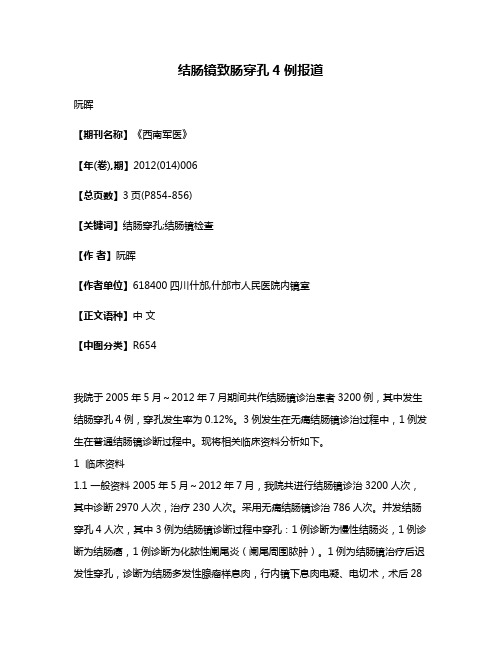
结肠镜致肠穿孔4例报道阮晖【期刊名称】《西南军医》【年(卷),期】2012(014)006【总页数】3页(P854-856)【关键词】结肠穿孔;结肠镜检查【作者】阮晖【作者单位】618400四川什邡,什邡市人民医院内镜室【正文语种】中文【中图分类】R654我院于2005年5月~2012年7月期间共作结肠镜诊治患者3200例,其中发生结肠穿孔4例,穿孔发生率为0.12%。
3例发生在无痛结肠镜诊治过程中,1例发生在普通结肠镜诊断过程中。
现将相关临床资料分析如下。
1 临床资料1.1 一般资料 2005年5月~2012年7月,我院共进行结肠镜诊治3200人次,其中诊断2970人次,治疗230人次。
采用无痛结肠镜诊治786人次。
并发结肠穿孔4人次,其中3例为结肠镜诊断过程中穿孔:1例诊断为慢性结肠炎,1例诊断为结肠癌,1例诊断为化脓性阑尾炎(阑尾周围脓肿)。
1例为结肠镜治疗后迟发性穿孔,诊断为结肠多发性腺瘤样息肉,行内镜下息肉电凝、电切术,术后28小时发生穿孔,均为男性患者。
年龄48-72岁,平均年龄57岁。
总的穿孔发生率为0.12%。
1.2 结肠镜诊治前准备患者结肠镜诊治前进食少渣食物1~3天,检查当天禁食,检查前6~8小h按照肠道清洁标准口服聚乙二醇电解质洗肠散或硫酸镁洗肠液,排便困难患者可配合清洁灌肠;结肠息肉内镜手术患者禁止服用甘露醇液洗肠。
大部分患者肠道能达到预期效果。
个别患者因肠道占位或炎性肠病肠道清洁度欠佳。
无痛结肠镜诊治时,由麻醉医师进行麻醉前评估后,在心电监护和吸氧下,进行静脉麻醉。
1.3 病例介绍病例1,患者男性,70岁。
因反复下腹痛3年,复发5天入院就诊。
入院后腹痛原因不明确。
腹部超声检查:肝胆、胰腺、脾脏、肾脏、输尿管未见异常。
胃镜检查诊断:浅表性胃炎。
进一步行结肠镜检查。
检查前患者述下腹部隐痛,腹部平坦、柔软,无肌紧张、反跳痛。
白细胞总数高。
行结肠镜检查,双人肠镜操作进境80cm至肝曲,阻力较大,反复退镜勾拉,无法进境。
临床分析溃疡性结肠炎患者的结肠镜检查分析
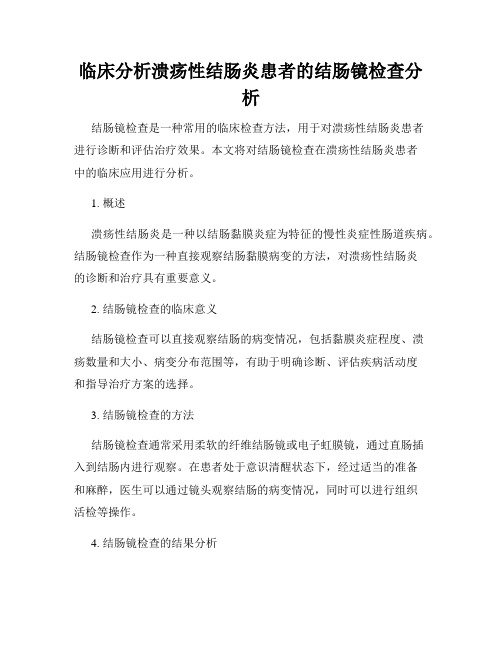
临床分析溃疡性结肠炎患者的结肠镜检查分析结肠镜检查是一种常用的临床检查方法,用于对溃疡性结肠炎患者进行诊断和评估治疗效果。
本文将对结肠镜检查在溃疡性结肠炎患者中的临床应用进行分析。
1. 概述溃疡性结肠炎是一种以结肠黏膜炎症为特征的慢性炎症性肠道疾病。
结肠镜检查作为一种直接观察结肠黏膜病变的方法,对溃疡性结肠炎的诊断和治疗具有重要意义。
2. 结肠镜检查的临床意义结肠镜检查可以直接观察结肠的病变情况,包括黏膜炎症程度、溃疡数量和大小、病变分布范围等,有助于明确诊断、评估疾病活动度和指导治疗方案的选择。
3. 结肠镜检查的方法结肠镜检查通常采用柔软的纤维结肠镜或电子虹膜镜,通过直肠插入到结肠内进行观察。
在患者处于意识清醒状态下,经过适当的准备和麻醉,医生可以通过镜头观察结肠的病变情况,同时可以进行组织活检等操作。
4. 结肠镜检查的结果分析结肠镜检查结果包括结肠黏膜炎症的程度、病变的分布范围以及溃疡的数量和大小等。
根据这些结果,可以进一步确定疾病的严重程度和活动度,并进行治疗方案的制定和调整。
5. 结肠镜检查在治疗过程中的应用结肠镜检查不仅可以用于溃疡性结肠炎的诊断,还可以在治疗过程中进行疗效评估。
通过定期的结肠镜检查,可以观察病变的变化,评估治疗的效果,并及时调整治疗方案,以达到最佳疗效。
6. 结肠镜检查的并发症与注意事项尽管结肠镜检查是一种常用的临床检查方法,但仍然存在一定的并发症风险,如肠道穿孔、出血、感染等。
因此,在进行结肠镜检查前,应充分评估患者的病情和手术风险,并做好相应的准备和预防措施。
7. 结论结肠镜检查作为一种直接观察结肠黏膜病变的方法,在溃疡性结肠炎的诊断和治疗过程中起到了重要的作用。
通过结肠镜检查能够明确病变情况,评估疾病活动度,并指导治疗方案的选择和调整,从而提高治疗效果,改善患者的生活质量。
本文对结肠镜检查在溃疡性结肠炎患者中的临床应用进行了综述,旨在为临床医生和患者提供参考依据。
内窥镜检查

内窥镜检查一、乙状结肠镜检查乙状结肠镜检查是诊断直肠、乙状结肠疾病的重要方法之一,大约70%左右的大肠癌都位于直肠和乙状结肠,因此乙状结肠镜检查对直肠和乙状结肠早期癌变的发现和确诊有重要意义。
1、乙状结肠镜检查的适应症:①便血或黑便患者。
②直肠内疑有肿块。
③慢性腹泻、大便长期有脓血或粘液。
④不明原因的大便习惯改变,如坠胀、便频或便秘等。
⑤大便形状改变或形态不规则。
⑥下消化道造影疑有结肠病变者。
2、乙状结肠镜检查的禁忌症:①肛门或直肠狭窄、肠内异物未取出者。
②肛门、直肠和乙状结肠急性炎症期。
③肛裂发作期。
④急性腹膜炎。
⑤精神病患者及不合作的儿童。
⑥高血压、心脏病、孕妇及体质极度衰弱者。
3、检查前准备:一般于检查前清洁灌肠,使之排空大便即可。
对于个别精神紧张患者可于术前1小时酌情给予镇静剂和解痉剂。
4、检查方法:患者取膝胸位,先作直肠指诊,了解有无直肠狭窄,然后于镜筒及镜栓涂抹润滑剂轻柔插入肛管,开始时镜顶端指向脐部,当进入5cm深度时,取出闭孔器,装上接目镜和充气球,缓缓打气,循腔进镜。
直视下首先可见到直肠壶腹部,此时向骶尾部前进、有无出血、溃疡、脓性分泌物、息肉、肿瘤等。
如有可疑病变肉眼尚不能定性者,可取活组织送病理检查。
乙状结肠镜检查时,要注意看清肠腔后才能进镜,操作要轻柔,切忌盲目和暴力推进,以免造成穿孔。
取活检时咬取组织不能太大、太深,同时要避开血管,防止组织损伤过多引起出血。
二、纤维结肠镜检查纤维结肠镜的应用,是胃肠病学上的一个重要进展,显著提高了大肠疾病以及包括回肠末段和回盲部疾病的检出率和诊断率,并通过纤维结肠镜进行摘除息肉、止血、乙状结肠扭转复位等非手术疗法。
(一)纤维结肠镜的基本构造和类型纤维结肠镜的基本结构是由光学系统和机械系统组成。
光学系统包括导像和导光系统。
在机械系统中包括弯曲及调节控制系统,注水、注气系统,吸引活检管道系统和金属软管、塑料管制成的外壳保护等组成。
从外观上可分成5个部分:头部、可控弯曲部、软管部、操作部、万能导索。
2023儿童结直肠息肉内镜治疗并发症预防及处理(全文)

2023儿童结直肠息肉内镜治疗并发症预防及处理(全文)摘要对于疑似因结直肠息肉而造成下消化道出血的患儿,使用结肠镜诊断及治疗已经成为非常重要的手段。
肠镜下息肉切除术后主要并发症有:出血、电凝综合征和穿孔。
与成人相比,儿童肠壁肌层薄、黏膜嫩、肠道屏障功能差,但合并症以及抗凝药使用少,这些特点决定了儿科内镜手术后并发症的相关风险及发生率与成人存在差别。
J科内镜医生需要根据患儿息肉的特点,采取相应措施预防相关并发症的发生。
该文介绍了儿童结直肠息肉内镜治疗后出血、电凝综合征和穿孔的相关风险因素、预防及治疗措施。
关键词结肠镜;息肉切除术;出血;电凝综合征;穿孔;并发症结直肠息肉是引起儿童下消化道出血的常见原因之一。
使用结肠镜进行诊断和治疗是规范诊治儿童结直肠息肉的重要措施。
目前儿童结直肠息肉内镜治疗主要包括冷(热)活检钳除法、冷(热)圈套器切除法、内镜下黏膜切除术(endoscopicmucosa1resection,EMR\高频电刀切除法、内镜下黏膜剥离术(endoscopicsubmucosa1dissection,ESD)以及氮离子凝固术(argonp1asmacoagu1ation,APC),适合对不同形态特征的结直肠息肉进行处理[1]o尽管这些治疗措施降低了结直肠息肉对儿童健康影响的风险,但在诊治过程中仍需要积极避免并发症的发生。
儿童结直肠息肉总体发病率较低,因此与成人相比,在儿科患者中进行息肉切除术的经验相对有限。
美国的一项回顾性研究发现,儿童息肉切除术后并发症发生率较高:总体发生率为10.9%,而需要医疗评估和介入的严重不良反应为9.4%[2-3]o目前,与结直肠息肉内镜治疗相关的并发症主要有以下几种:息肉切除术后出血(post-po1ypectomyb1eeding,PPB∖电凝综合征(post-po1ypectomycoagu1ationsyndrome,PPCS)和穿孔[4J O 本文将介绍与这几种并发症相关的风险因素及其预防和处理措施。
结肠镜检查知情同意书
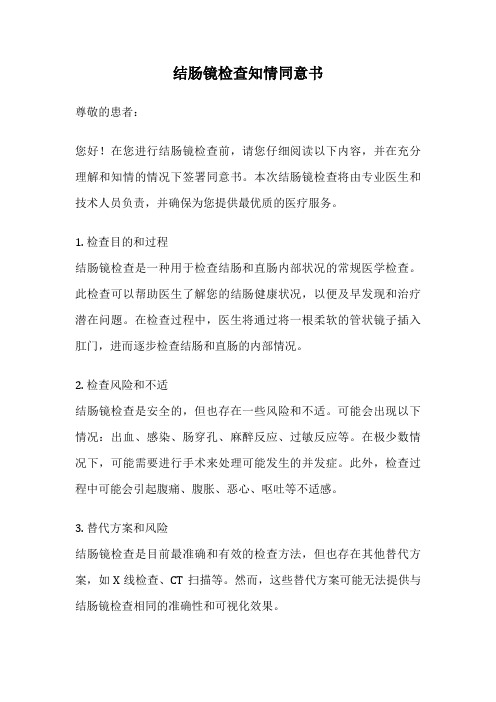
结肠镜检查知情同意书尊敬的患者:您好!在您进行结肠镜检查前,请您仔细阅读以下内容,并在充分理解和知情的情况下签署同意书。
本次结肠镜检查将由专业医生和技术人员负责,并确保为您提供最优质的医疗服务。
1. 检查目的和过程结肠镜检查是一种用于检查结肠和直肠内部状况的常规医学检查。
此检查可以帮助医生了解您的结肠健康状况,以便及早发现和治疗潜在问题。
在检查过程中,医生将通过将一根柔软的管状镜子插入肛门,进而逐步检查结肠和直肠的内部情况。
2. 检查风险和不适结肠镜检查是安全的,但也存在一些风险和不适。
可能会出现以下情况:出血、感染、肠穿孔、麻醉反应、过敏反应等。
在极少数情况下,可能需要进行手术来处理可能发生的并发症。
此外,检查过程中可能会引起腹痛、腹胀、恶心、呕吐等不适感。
3. 替代方案和风险结肠镜检查是目前最准确和有效的检查方法,但也存在其他替代方案,如X线检查、CT扫描等。
然而,这些替代方案可能无法提供与结肠镜检查相同的准确性和可视化效果。
4. 麻醉和镇静为了减轻您的不适和不适感,通常会使用麻醉和镇静药物。
在使用这些药物之前,您需要告知医生有关您的过敏史、药物使用情况和其他相关疾病。
麻醉和镇静可能会引起一些不适和并发症,但这些情况在经验丰富的医疗团队的指导下可以得到控制。
5. 结果解读和后续处理结肠镜检查的结果将由医生进行解读和评估。
如果发现异常情况,可能需要进一步检查或治疗措施。
医生将与您沟通并制定相应的治疗计划。
6. 隐私和保密我们将严格遵守医疗保密法律法规,保护您的个人隐私和医疗信息安全。
7. 自愿参与和知情同意您参与结肠镜检查是基于自愿原则,并且在充分理解和知情的情况下签署此同意书。
如果您对本次检查有任何疑问或担忧,我们将乐意为您解答。
请您在确认理解以上内容后,签署以下知情同意书:我已阅读并理解上述内容,我对结肠镜检查的目的、过程、风险和不适以及可能的替代方案有充分的了解。
我已向医生提供了真实和完整的个人信息,并同意在医生的指导下进行结肠镜检查。
有关结肠镜检查的科普知识

有关结肠镜检查的科普知识结肠镜检查是现阶段检查炎症、腺瘤以及结肠癌等各类疾病的首先检查方式,也是结直肠癌疾病诊断以及质量的最主要方法,在镜下可以取样组织实施样本病理,必要情况下采取手术干预,为患者病情改善提供帮助。
近年来,随着临床医学快速发展,内镜专家对于结肠镜检查研究越来越深入,结肠镜检查质量和效率也随之增强,在医学领域应用发生极大改变。
一、结肠镜检查前准备(一)肠道准备良好肠道清洁水平对结肠镜检查质量有着极大的影响,充分、合理的肠道准备能够让腺瘤检出率以及盲肠探索率不断提升,与肠道准备不充分、不到位患者相对比,可以让结肠内扁平病变检出率不断增强。
其中饮食与肠道清洁剂是肠道准备的最关键、最核心两个因素。
一是饮食,过往饮食准备手段主要为禁食,在检查前一段时间禁止饮食,以此来增强临床检查效率。
不过,近年来有临床研究显示,低纤维饮食、全流质饮食对肠道准备质量提升也有一定帮助,与禁食相对比低纤维以及全流质饮食可以让患者对肠道准备的满意度以及忍受度增强。
因此,有学者推荐,在结肠镜检查前1d左右,可引导患者进食少渣低纤维饮食,提升患者再次实施结肠镜检查的意愿以及满意程度。
二是肠道清洁剂,近年来,随着临床医学的发展,肠道清洁剂制剂已经逐步从过往蕴含高渗盐水的大剂量溶液(剂量为7-12L),转变成为蕴含电解质以及聚乙二醇(PEG)的等渗溶液,常见药物为聚乙二醇电解质散,此类肠道清洁制剂为肠道准备提供极大的便利,对于肾衰竭、电解质紊乱、腹水患者属于一种安全性较高的清肠手段。
不过为保证肠道清洁质量以及结肠镜检查效率,在药物使用之前需要针对患者肾脏功能进行评估,对于肾功能有一定衰竭的患者,要尽量应用PEG。
在结肠镜检查之前,可利用分次的肠道准备方案,其中一般剂量在结肠镜检查前1d给药,另一半则需要在检查当天给药,全面、显著增强肠道清洁程度,可让扁平病变以及ADR检出率增强,让药物准备安全程度以及耐受性能不断提升。
此外,除了聚乙二醇电解质散之外,磷酸钠口服溶液也是一种较为常见的高渗性溶液,与聚乙二醇电解质散具备的效果十分相似。
电子结肠镜检查致肠穿孔并发症的影响因素及对策

colonoscopy and treatm ent strategy
WANG Guang—yong,ZHOU Guo—zhong, Jiao,Sill Yun.xing
(Department ofGastroenterology No.411 Hospital ofCPLA,Shanghai 200081,China)
[作者单位] 200081 上海 ,解放军第四一一医院消化 内科
1 临床 资料 1.1 一般 资料
2003—12至 2013—12,我 院共进 行 电子 结肠 镜 检 查 3 651例 人 次 ,其 中常 规肠 镜 3 012人 次 ,无 痛 肠 镜 639人次 ,诊 断 3 345人 次 ,治疗 306人 次 。并 发 肠镜 穿孔 4例 。男性 2例 ,女 性 2例 。年 龄 51— 80岁 ,平均 年龄 64.4岁 。其 中诊 断性 穿孔 3例 ,治 疗 性穿 孔 1例 。无 痛肠镜 检查 3例 ,常规肠 镜检 查 1 例。3例在乙状结肠 ,1例在 回盲部 。1例诊 断为结 肠息肉,2例诊断为结肠肿瘤 ,1例诊 断为慢性结肠 炎 ;总 的穿 孑L发生率 为 0.11% 。
- 1、下载文档前请自行甄别文档内容的完整性,平台不提供额外的编辑、内容补充、找答案等附加服务。
- 2、"仅部分预览"的文档,不可在线预览部分如存在完整性等问题,可反馈申请退款(可完整预览的文档不适用该条件!)。
- 3、如文档侵犯您的权益,请联系客服反馈,我们会尽快为您处理(人工客服工作时间:9:00-18:30)。
This is one of a series of position statements discussing the use of GI endoscopy in common clinical situations. The Standards of Practice Committee of the American Society for Gastrointestinal Endoscopy prepared this text. In preparing this document,the authors performed a search of the medical literature by using PubMed.Addi-tional references were obtained from the bibliographies of the identified articles and from recommendations of ex-pert consultants.When limited or no data existed from well-designed prospective trials,emphasis was given to results from large series and reports from recognized ex-perts.Position statements are based on a critical review of the available data and expert consensus at the time the documents are drafted.Further controlled clinical studies may be needed to clarify aspects of this document,which may be revised as necessary to account for changes in technology,new data,or other aspects of clinical practice.This document is intended to be an educational device to provide information that may assist endoscopists in providing care to patients.This position statement is not a rule and should not be construed as establishing a legal standard of care or as encouraging,advocating,requir-ing,or discouraging any particular treatment.Clinical decisions in any particular case involve a complex anal-ysis of the patient’s condition and available courses of action.Therefore,clinical considerations may lead an endoscopist to take a course of action that varies from this position statement.This document is an update of the 2003ASGE document entitled“Complications of colonos-copy.”1Colonoscopy is a commonly performed procedure for the diagnosis and treatment of a wide range of conditions and symptoms and for the screening and surveillance of colorectal neoplasia.Although up to33%of patients report at least one minor,transient GI symptom after colonos-copy,2serious complications are uncommon.In a2008 systematic review of12studies totaling57,742colonosco-pies performed for average risk screening,the pooled overall serious adverse event rate was2.8per1000pro-cedures.3The risk of some complications may be higher if the colonoscopy is performed for an indication other than screening.4The colorectal cancer miss rate of colonoscopy has been reported to be as high as6%,5and the miss rate for adenomas larger than1cm is12%to17%.6-7Although missed lesions are considered a poor outcome of colono-scopy,they are not a complication of the procedure per se and will not be discussed further in this -plications of bowel preparations are discussed in the American Society for Gastrointestinal Endoscopy Technol-ogy Status Evaluation Report for Colonoscopy Prepara-tion.8Over85%of the serious colonoscopy complications are reported in patients undergoing colonoscopy with polypectomy.3An analysis of Canadian administrative data,including over97,000colonoscopies,found that polypectomy was associated with a7-fold increase in the risk of bleeding or perforation.9However,complication data are often not stratified by whether or not polypec-tomy was performed.Therefore,complications of polypectomy are discussed with those of diagnostic colonoscopy.A discussion of the diagnosis and manage-ment of all complications of colonoscopy is beyond the scope of this document,although general principles are reviewed.CARDIOPULMONARY COMPLICATIONS Cardiovascular and pulmonary complications related to sedation are reviewed in detail in the2008American Society for Gastrointestinal Endoscopy Guideline for Se-dation and Anesthesia in GI Endoscopy.10Intraprocedural cardiopulmonary complications have been variably de-fined to include events of unclear clinical significance, such as minorfluctuations in oxygen saturation or heart rate,to significant complications including respiratory ar-rest,cardiac arrhythmias,myocardial infarction,and shock.11In a study that used the Clinical Outcomes Re-search Initiative(CORI)database,cardiopulmonary com-plications occurred in0.9%of procedures and made up 67%of the unplanned events during or after endoscopic procedures with sedation.12Transient hypoxemia oc-curred in230per100,000colonoscopies,but prolonged hypoxemia was reported in only0.78per100,000colono-scopies.Hypotension occurred in480per100,000colono-scopies.CORI data may underestimate acute complica-tions because of missing data and underreporting.A2008 systematic review of randomized,controlled trials of pa-tients undergoing colonoscopy and/or EGD reported much higher cardiopulmonary event rates with a weighted rate of6%to11%for hypoxemia and5%to7%for hypo-tension,depending on the specific drug regimen used.13Copyright©2011by the American Society for Gastrointestinal Endoscopy 0016-5107/$36.00doi:10.1016/j.gie.2011.07.025In addition to acute complications,colonoscopy is as-sociated with an increased incidence of cardiovascular events in the30-day postprocedure period.A study of Medicare beneficiaries reported an unadjusted rate of car-diovascular events requiring hospitalization or emergency department visits of1030per100,000procedures,which was significantly higher compared with matched controls (885/100,000procedures).4In a prospective study of pa-tients undergoing colonoscopy at CORI sites,the event rate at30days was1.4per1000for angina,myocardial infarction,stroke,or transient ischemic attack.14 It is known that the risk of cardiopulmonary events associated with colonoscopy is increased with advanced age,4higher American Society of Anesthesiologists Physi-cal Status Classification System scores,15-16and the presence of comorbidities.4Appropriate assessment of anesthesia risk prior to colonoscopy may reduce cardiopulmonary compli-cations by ensuring that high-risk patients are co-managed with other specialists(eg,cardiology,anesthesiology).Ap-propriate monitoring before,during,and after the procedure also may reduce the risk of complications.Unstable patients should have non-emergent colonoscopy delayed as appro-priate.In addition,continuing aspirin and other antiplatelet agents in the peri-endoscopic period may reduce the risk of cardiovascular events.The current American Society for Gas-trointestinal Endoscopy Guideline for Management of Anti-thrombotic Agents for Endoscopic Procedures stresses that the risks of bleeding while receiving antithrombotic therapy must be weighed against the risks of a thrombotic event if that therapy is withheld.17Although many thrombotic events may be devastating,procedure-related GI bleeding is usually manageable and infrequently associated with significant morbidity or mortality.17PERFORATIONColonic perforation during colonoscopy may result from mechanical forces against the bowel wall,baro-trauma,or as a direct result of therapeutic procedures. Early symptoms of perforation include persistent abdom-inal pain and abdominal ter,patients may develop peritonitis.Plain radiographs of the chest and abdomen may demonstrate free air,although CT scans have been shown to be superior to the upright chestfilm.18 Therefore,an abdominal CT scan should be considered for patients with an unrevealing plainfilm in whom there is a high suspicion of perforation.The rate of perforation reported in large studies is0.3% or less and is generally less than0.1%.2In a large study of screening colonoscopy,perforation was reported in13of 84,412procedures(0.01%).19In a case-controlled study of277,434Medicaid beneficiaries undergoing colonos-copy,the rate of perforation was8.2per10,000proce-dures(0.08%)compared with0.3per10,000matched controls(0.003%).20In a study analyzing over50,000 colonoscopies and using Medicare claims data,the rate of perforation was5to7per10,000procedures(0.05%-0.07%)and not significantly different for procedures coded as screening without polypectomy,diagnostic with-out polypectomy,or with polypectomy(regardless of in-dication).4Finally,in a large study of116,000patients undergoing colonoscopy at ambulatory endoscopy cen-ters,there were37perforations(0.3%).21Surgical consultation should be obtained in all cases of perforation.Although perforation often requires surgical repair,nonsurgical management may be appropriate in select individuals.22There is an increasing number of case reports demonstrating the feasibility of using endoscopic clipping devices to repair perforations.23There is evidence that performance of colonoscopy by an endoscopist with low procedure volume is associated with increased risk of perforation and bleeding.9Creating afluid cushion at the base or under large polyps in order to increase the degree of separation of the mucosal layers has been described as a technique to potentially reduce the risk of postpolypectomy perforation.24It has been suggested that perforation rates greater than1in500for all colonoscopies or1in1000for screening colonoscopies should prompt evaluation of whether inappropriate prac-tices are being used.24HEMORRHAGEHemorrhage is most often associated with polypec-tomy,although it can occur during diagnostic colonos-copy.When associated with polypectomy,hemorrhage may occur immediately or can be delayed for several weeks after the procedure.25A number of large studies have reported hemorrhage in1to6per1000colonosco-pies(0.1%-0.6%).2A study analyzing over50,000colono-scopies by using Medicare claims found that the rate of GI hemorrhage was significantly different with or without polypectomy:2.1per1000procedures coded as screening without polypectomy and3.7per1000for procedures coded as diagnostic without polypectomy,compared with 8.7per1000for any procedures with polypectomy.4Polyp size has been reported as a risk factor for postpolypectomy bleeding in several studies.26-30Addi-tional risk factors may include the number of polyps removed,31-32recent warfarin therapy,28,33-34and polyp histology.26,35Patient comorbidities,such as cardiovas-cular disease,4,26,28may increase the risk for bleeding but also may be markers for anticoagulation use.34Mul-tiple,large studies did notfind aspirin use associated with postpolypectomy bleeding.33-34,36Another retro-spective study found that concomitant use of either aspirin or nonsteroidal anti-inflammatory drugs and clopidogrel was an independent risk factor for bleeding, but aspirin or clopidogrel use alone was not.31Recom-mendations for the management of antithrombotic ther-apy in the peri-endoscopic period are discussed in de-tail in another ASGE document.17Complications of colonoscopyThe site of active bleeding can be identified endoscop-ically,through red blood cell nuclear scintigraphy,or an-giographically.37Acute postpolypectomy hemorrhage of-ten is immediately apparent and amenable to endoscopic therapy.38-39Nonendoscopic treatment modalities include angiographic embolization and surgery.40Using mini-snare resection without electrocautery in-stead of hot-biopsy forceps for removal of diminutive polyps may reduce bleeding.41The prophylactic use of mechanical methods,such as clips or detachable snares has been reported.42-43A randomized,controlled trial of prophylactic,detachable snare placement prior to polypectomy in89patients with large,pedunculated pol-yps found a significant reduction in bleeding in the de-tachable snare group(0%vs12%).43The placement of endoscopic clips after removal of colon polyps may be beneficial in select patients,although the data are mixed.35,44Injection of epinephrine prior to polypectomy was reported to reduce the incidence of immediate post-polypectomy bleeding,although there was no demon-strated effect on delayed bleeding.45,46It has been sug-gested that postprocedure bleeding rates of greater than 1%should prompt evaluation of whether inappropriate practices are being used.24 POSTPOLYPECTOMY ELECTROCOAGULATION SYNDROMEPostpolypectomy electrocoagulation syndrome is the result of electrocoagulation injury to the bowel wall that induces a transmural burn and localized peritonitis with-out evidence of perforation on radiographic studies.The reported incidence of this complication varies widely from 3per100,000(0.003%)to1in1000(0.1%).2Typically,patients with postpolypectomy electrocoag-ulation syndrome present1to5days after colonoscopy with fever,localized abdominal pain,localized peritoneal signs,and leukocytosis.It is important to recognize this entity because it does not require surgical treatment.Post-polypectomy electrocoagulation syndrome usually is man-aged with intravenous hydration,broad-spectrum paren-teral antibiotics,and nothing by mouth until the symptoms subside.47Successful outpatient management with oral antibiotics has also been reported.48MORTALITYDeath has been rarely reported in relation to colonos-copy,with or without polypectomy.In a2010review of colonoscopy complications based on prospective studies and retrospective analyses of large clinical or administra-tive databases,there were128deaths reported among 371,099colonoscopies,for an unweighted pooled death rate of0.03%.2All studies reported mortality within30 days of the colonoscopy,although some reported all-cause mortality whereas others limited their analysis to colonoscopy-specific mortality.Those reporting all-cause mortality include116deaths among176,834patients (0.07%).4,9,14,49-52Among those reporting colonoscopy-specific mortality,there were19deaths among284,097 patients(0.007%).9,19,49-56INFECTIONTransient bacteremia after colonoscopy,with or with polypectomy,occurs in approximately4%of procedures, with a range of0%to25%.57However,signs or symptoms of infection are rare.57Although individual cases of infec-tion after colonoscopy have been reported,there is no definite causal link with the endoscopic procedure and no proven benefit for antibiotic prophylaxis.58Therefore,cur-rent guidelines from the American Heart Association and ASGE recommend against antibiotic prophylaxis for pa-tients undergoing colonoscopy.58-59A2008review60re-ported that subsequent to the2003Multisociety Guideline for Reprocessing of Flexible GI Endoscopes,61all reported cases of transmission of infection resulted from defective equipment and/or failure to adhere to reprocessing guide-lines.The Multisociety Guideline for Reprocessing of Flex-ible GI Endoscopes was updated most recently in2011.62 GAS EXPLOSIONExplosive complications of colonoscopy are rare,but they have serious consequences.A2007review reported9 cases,each resulting in colonic perforation and,in one case,death.63Gas explosion can occur when combustible levels of hydrogen or methane gas are present in the colonic lumen,oxygen is present,and electrosurgical en-ergy is used(eg,electrocautery or argon plasma coagula-tion).Suspected risk factors are use of nonabsorbable or incompletely absorbable carbohydrate preparations,such as mannitol,lactulose,or sorbitol,64-65and incomplete co-lonic cleansing either because a sigmoidoscopy prepara-tion was used(eg,enemas)or because the result of a colonoscopic purge preparation was inadequate.66Some authors have advocated use of carbon dioxide during colonoscopy as a preventive measure.67 ABDOMINAL PAIN OR DISCOMFORTLess severe,but more common,sequelae of colonos-copy are also important and can impact patient adherence to future colonoscopy.2The most commonly reported mi-nor complications of colonoscopy are bloating(25%)68 and abdominal pain and/or discomfort5%to11%.68-70 Appropriate techniques,such as avoiding and reducing endoscope looping and minimizing air insufflation should help reduce these symptoms.71In addition,randomized trials have demonstrated less postprocedure pain with carbon dioxide compared with standard air insufflation.72-77A water immersion technique that avoids air insufflation alsoComplications of colonoscopymay reduce pain,especially in the setting of minimal or no sedation.78-79MISCELLANEOUS COMPLICATIONSMiscellaneous complications of colonoscopy include splenic rupture,80-81acute appendicitis,82diverticulitis,2 subcutaneous emphysema,83-84and tearing of mesenteric vessels with intraabdominal hemorrhage.Chemical colitis may occur if glutaraldehyde,used during disinfection,has not been adequately rinsed from the endoscope.85 COMPLICATIONS ASSOCIATED WITH SPECIFIC COLONOSCOPIC INTERVENTIONSColonoscopic tattooingWhen a lesion requires marking to aid localization for surgical removal or endoscopic follow-up,a permanent dye is injected to tattoo the colon adjacent to the lesion.86 Use of sterile and appropriately diluted solutions has a low rate(0.2%)of complications.87Colonic dilationColonic dilation has been used to treat benign strictures at surgical anastomoses and those associated with Crohn’s disease.88Two prospective studies with a total of42pa-tients with anastomotic strictures not from Crohn’s disease reported no complications after dilation.89,90In contrast,a systematic review of13studies with347patients with Crohn’s disease with colonic strictures reported dilation-related complication rates of0%to18%,with a pooled complication rate of2%.91Almost all complications were perforations.Colonic stent placementThree pooled analyses of29to88retrospective studies totaling598to1785patients have yielded similar results for adverse events in the setting of self-expandable metal stents(SEMS)used for malignant obstruction.92-94The pooled perforation rates ranged from3.7%to4.5%.The pooled stent migration rates ranged from9.8%to11.8%, and the stent occlusion rates ranged from7.3%to12%. Dilation before or immediately after stent placement is not recommended because of the increased perforation risk.88 Since the publication of the pooled analyses,3random-ized,controlled trials of SEMS compared with surgery were closed early because of high rates of complications in the SEMS arms.These complications included6perfo-rations and5anastomotic leaks among47participants,953 perforations among11participants,96and2perforations among30participants(of whom only14had a stent placed;ie,47%technical success rate).97In contrast,a randomized,controlled trial of SEMS as a bridge to surgery (Nϭ24in the SEMS arm)reported no stent-related com-plications.98The difference in estimated complication rates among the studies may be related to patient population, endoscopist experience,and study design.Colonic decompression tube placement The studies examining colonic decompression tube outcomes are limited in size.In3series consisting of139 patients with colonic obstruction,one perforation was reported.99-101A series of50patients with pseudo-obstruction who underwent62colonoscopies with54 decompression tube placements included one perforation (2%per-patient rate)and an in-hospital mortality rate of 30%,reflecting the underlying comorbidities of patients with pseudo-obstruction.102Percutaneous endoscopic colostomyPercutaneous endoscopic colostomy has been used to treat slow-transit constipation,recurrent sigmoid volvulus, colonic pseudo-obstruction,and neurogenic bowel in pa-tients refractory to other interventions and considered poor surgical candidates.88Series of percutaneous endo-scopic colostomy report major complications in5%to12% (mostly peritonitis),with a3%to7%rate of procedure-related mortality.103-105Minor complications,such as site infection,buried bumper,and abdominal wall bleeding, exceeded30%in the only prospective series.103Most re-ports describe an all-cause in-hospital mortality rate ex-ceeding25%,reflecting the often frail patients who pop-ulate these series.103-105Colonoscopic hemostasisGeneral descriptions of hemostasis techniques,effi-cacy,and safety are discussed in a2009American Society for Gastrointestinal Endoscopy Technology Status Evalua-tion Report.39The use of any hemostatic technique can initially worsen bleeding,but frequently this can be suc-cessfully treated by additional application of the same device or use of another hemostatic device.Colonic per-foration is a rare complication of endoscopic hemostasis. However,among patients undergoing treatment of angi-ectasia,particularly in the right colon,perforation has been reported in up to2.5%of cases.106The rare compli-cation of gas explosion during use of argon plasma coag-ulation is discussed earlier.Foreign body removalColorectal foreign bodies are primarily the result of objects inserted per rectum or swallowed(eg,bones, toothpicks).107There also are case reports of migration of extraintestinal foreign bodies into the large intestine(eg, intrauterine contraceptive devices108and inguinal hernia mesh109).A foreign body may cause colonic obstruction. Perforation is a primary concern;the perforation rate likely varies considerably with the type of object(eg,sharp vs blunt)and traumatic versus nontraumatic insertion.107In the case of body packing,that is,transporting illegal drugs by swallowing or inserting plastic bags or condomsfilledComplications of colonoscopywith the drug,there is the additional risk of rupture of the bag/condom during attempted removal.This can lead to systemic absorption of the drug,overdose,and,poten-tially,death.107Therefore,it is recommended that endo-scopic removal of drug-containing packets should not be attempted.110Prior to any attempted removal of a foreign body,an abdominal plainfilm to evaluate for free air is recom-mended.107,111In a series of83episodes of a rectal foreign body in87patients,74%were successfully removed nonoperatively.112Advanced techniques for colonoscopictissue removalEndoscopic mucosal resection(EMR)and endoscopic submucosal dissection(ESD)are advanced techniques used to remove suspected premalignant and early stage malignant lesions.113As with standard polypectomy,bleeding and per-foration are the most common complications with EMR and ESD,but they occur more frequently with these advanced techniques.The reported complication rates vary.Lesion size,location,and histology and operator experience may all contribute to this variability.114-116The intraprocedural bleeding rate is over10%in several large series,with delayed bleeding reported in1.5%to 14%of cases.113,114Bleeding complications are usually endoscopically manageable,although the need for trans-fusions has been reported.117Perforation complicates ap-proximately5%to10%of colonic ESD resections114-115,117 and,less commonly,complicates EMR resections(0%-5%).118The majority of perforations are recognized at the time of the procedure and are usually successfully man-aged with endoscopic clip closure.114-115,117 CONCLUSIONComplications are inherent in the performance of colonoscopy.As endoscopy assumes a more therapeutic role in the management of GI disorders,the potential for complications will likely increase.Knowledge of potential endoscopic complications,their expected frequency,and the risk factors associated with their occurrence may help to minimize the incidence of complications.Endoscopists are expected to carefully select patients for the appropriate intervention,be familiar with the planned procedure and available technology,and be prepared to manage any adverse events that may arise.Once a complication oc-curs,early recognition and prompt intervention will min-imize the morbidity and mortality associated with that complication.Review of complications as part of a con-tinuing quality improvement process may serve to educate endoscopists,help to reduce the risk of future complica-tions,and improve the overall quality of endoscopy.119DISCLOSURED.Fisher is a consultant for Epigenomics.P.Malpas is a consultant for Olympus America.J.Dominitz is a con-sultant for Epigenomics and Salix Pharmaceuticals.B. Cash is a consultant for Salix Pharmaceuticals,J.Evans is a consultant for Cook Medical.G.Decker is a consul-tant for Facet Biotechnology.No otherfinancial rela-tionships relevant to this publication were disclosed. Abbreviations:CORI,Clinical Outcomes Research Initiative;ESD,endo-scopic submucosal dissection;SEMS,self-expandable metal stent. REFERENCES1.Dominitz JA,Eisen GM,Baron TH,et plications of colonoscopy.Gastrointest Endosc2003;57:441-5.2.Ko CW,Dominitz plications of colonoscopy:magnitude andmanagement.Gastrointest Endosc Clin N Am2010;20:659-71.3.Whitlock EP,Lin JS,Liles E,et al.Screening for colorectal cancer:atargeted,updated systematic review for the U.S.Preventive Ser-vices Task Force.[see comment][summary for patients in Ann Intern Med2008;149:I-44;PMID:18838719Epub2008Oct6].Ann Int Med 2008;149:638-58.4.Warren JL,Klabunde CN,Mariotto AB,et al.Adverse events after out-patient colonoscopy in the Medicare population.Ann Intern Med 2009;150:849-57,W152.5.Bressler B,Paszat LF,Chen Z,et al.Rates of new or missed colorectalcancers after colonoscopy and their risk factors:a population-based analysis.Gastroenterology2007;132:96-102.6.Pickhardt PJ,Nugent PA,Mysliwiec PA,et al.Location of adenomasmissed by optical colonoscopy.Ann Intern Med2004;141:352-9.7.Van Gelder RE,Nio CY,Florie J,et puted tomographic colonog-raphy compared with colonoscopy in patients at increased risk for colorectal cancer.Gastroenterology2004;127:41-8.8.Mamula P,Adler DG,Conway JD,et al.Colonoscopy preparation.Gas-trointest Endosc2009;69:1201-9.9.Rabeneck L,Paszat LF,Hilsden RJ,et al.Bleeding and perforation afteroutpatient colonoscopy and their risk factors in usual clinical practice.Gastroenterology2008;135:1899-1906,1906e1891.10.Lichtenstein DR,Jagannath S,Baron TH,et al.Sedation and anesthesiain GI endoscopy.Gastrointest Endosc2008;68:815-26.11.Cotton PB,Eisen GM,Aabakken L,et al.A lexicon for endoscopic ad-verse events:report of an ASGE workshop.Gastrointest Endosc2010;71:446-54.12.Sharma VK,Nguyen CC,Crowell MD,et al.A national study of cardio-pulmonary unplanned events after GI endoscopy.Gastrointest Endosc 2007;66:27-34.13.McQuaid KR,Laine L.A systematic review and meta-analysis of ran-domized,controlled trials of moderate sedation for routine endo-scopic procedures.Gastrointest Endosc2008;67:910-23.14.Ko CW,Riffle S,Michaels L,et al.Serious complications within30daysof screening and surveillance colonoscopy are uncommon.Clin Gas-troenterol Hepatol2010;8:166-73.15.Baudet JS,Diaz-Bethencourt D,Aviles J,et al.Minor adverse events ofcolonoscopy on ambulatory patients:the impact of moderate seda-tion.Eur J Gastroenterol Hepatol2009;21:656-61.16.Vargo JJ,Holub JL,Faigel DO,et al.Risk factors for cardiopulmonaryevents during propofol-mediated upper endoscopy and colonoscopy.Aliment Pharmacol Ther2006;24:955-63.17.Anderson MA,Ben-Menachem T,Gan SI,et al.Management of anti-thrombotic agents for endoscopic procedures.Gastrointest Endosc 2009;70:1060-70.18.Stapakis JC,Thickman D.Diagnosis of pneumoperitoneum:abdominalCT vs.upright chestfilm.J Comput Assist Tomogr1992;16:713-6.Complications of colonoscopy19.Sieg A,Hachmoeller-Eisenbach U,Eisenbach T.Prospective evaluationof complications in outpatient GI endoscopy:a survey among German gastroenterologists.Gastrointest Endosc2001;53:620-7.20.Arora G,Mannalithara A,Singh G,et al.Risk of perforation from acolonoscopy in adults:a large population-based study.Gastrointest Endosc2009;69(3,pt2):654-64.21.Korman LY,Overholt BF,Box T,et al.Perforation during colonoscopy inendoscopic ambulatory surgical centers.Gastrointest Endosc2003;58: 554-7.22.Orsoni P,Berdah S,Verrier C,et al.Colonic perforation due to colono-scopy:a retrospective study of48cases.Endoscopy1997;29:160-4. 23.Trecca A,Gaj F,Gagliardi G.Our experience with endoscopic repair oflarge colonoscopic perforations and review of the literature.Tech Coloproctol2008;12:315-21;discussion322.24.Rex DK,Petrini JL,Baron TH,et al.Quality indicators for colonoscopy.Gastrointest Endosc2006;63(suppl4):S16-28.25.Singaram C,Torbey CF,Jacoby RF.Delayed postpolypectomy bleed-ing.Am J Gastroenterol1995;90:146-7.26.Consolo P,Luigiano C,Strangio G,et al.Efficacy,risk factors and com-plications of endoscopic polypectomy:ten year experience at a single center.World J Gastroenterol212008;14:2364-9.27.Dafnis G,Ekbom A,Pahlman L,et plications of diagnostic andtherapeutic colonoscopy within a defined population in Sweden.Gas-trointest Endosc2001;54:302-9.28.Kim HS,Kim TI,Kim WH,et al.Risk factors for immediate postpolypec-tomy bleeding of the colon:a multicenter study.Am J Gastroenterol 2006;101:1333-41.29.Shiffman ML,Farrel MT,Yee YS.Risk of bleeding after endoscopic bi-opsy or polypectomy in patients taking aspirin or other NSAIDS.Gas-trointest Endosc1994;40:458-62.30.Watabe H,Yamaji Y,Okamoto M,et al.Risk assessment for delayedhemorrhagic complication of colonic polypectomy:polyp-related fac-tors and patient-related factors.Gastrointest Endosc2006;64:73-78.31.Singh M,Mehta N,Murthy UK,et al.Postpolypectomy bleeding in pa-tients undergoing colonoscopy on uninterrupted clopidogrel therapy.Gastrointest Endosc2010;71:998-1005.32.Witt DM,Delate T,McCool KH,et al.Incidence and predictors of bleed-ing or thrombosis after polypectomy in patients receiving and not re-ceiving anticoagulation therapy.J Thromb Haemost2009;7:1982-89.33.Hui AJ,Wong RM,Ching JY,et al.Risk of colonoscopic polypectomybleeding with anticoagulants and antiplatelet agents:analysis of1657 cases.Gastrointest Endosc2004;59:44-8.34.Sawhney MS,Salfiti N,Nelson DB,et al.Risk factors for severe delayedpostpolypectomy bleeding.Endoscopy2008;40:115-9.35.Luigiano C,Ferrara F,Ghersi S,et al.Endoclip-assisted resection of largepedunculated colorectal polyps:technical aspects and outcome.Dig Dis Sci2010;55:1726-31.36.YousfiM,Gostout CJ,Baron TH,et al.Postpolypectomy lower gastro-intestinal bleeding:potential role of aspirin.Am J Gastroenterol2004;99:1785-9.37.Gibbs DH,Opelka FG,Beck DE,et al.Postpolypectomy colonic hemor-rhage.Dis Colon Rectum1996;39:806-10.38.Carpenter S,Petersen BT,Chuttani R,et al.Polypectomy devices.Gas-trointest Endosc2007;65:741-9.39.Conway JD,Adler DG,Diehl DL,et al.Endoscopic hemostatic devices.Gastrointest Endosc2009;69:987-96.40.Sorbi D,Norton I,Conio M,et al.Postpolypectomy lower GI bleeding:descriptive analysis.Gastrointest Endosc2000;51:690-6.41.Tappero G,Gaia E,De Giuli P,et al.Cold snare excision of small colorec-tal polyps.Gastrointest Endosc1992;38:310-3.42.Iida Y,Miura S,Munemoto Y,et al.Endoscopic resection of largecolorectal polyps using a clipping method.Dis Colon Rectum1994;37:179-80.43.Iishi H,Tatsuta M,Narahara H,et al.Endoscopic resection of large pe-dunculated colorectal polyps using a detachable snare.Gastrointest Endosc1996;44:594-7.44.Shioji K,Suzuki Y,Kobayashi M,et al.Prophylactic clip application doesnot decrease delayed bleeding after colonoscopic polypectomy.Gas-trointest Endosc2003;57:691-4.45.Hsieh YH,Lin HJ,Tseng GY,et al.Is submucosal epinephrine injectionnecessary before polypectomy?A prospective,comparative study.Hepatogastroenterology2001;48:1379-82.46.Di Giorgio P,De Luca L,Calcagno G,et al.Detachable snare versusepinephrine injection in the prevention of postpolypectomy bleeding:a randomized and controlled study.Endoscopy2004;36:860-3.47.Nivatvongs plications in colonoscopic polypectomy.an experi-ence with1,555polypectomies.Dis Colon Rectum1986;29:825-30. 48.Waye JD,Lewis BS,Yessayan S.Colonoscopy:a prospective report ofcomplications.J Clin Gastroenterol1992;15:347-51.49.Levin TR,Zhao W,Conell C,et plications of colonoscopy in anintegrated health care delivery system.Ann Intern Med2006;145: 880-6.50.Imperiale TF,Wagner DR,Lin CY,et al.Risk of advanced proximal neo-plasms in asymptomatic adults according to the distal colorectalfind-ings.N Engl J Med2000;343:169-74.51.Nelson DB,McQuaid KR,Bond JH,et al.Procedural success and com-plications of large-scale screening colonoscopy.Gastrointest Endosc 2002;55:307-14.52.Rathgaber SW,Wick TM.Colonoscopy completion and complicationrates in a community gastroenterology practice.Gastrointest Endosc 2006;64:556-62.53.Viiala CH,Zimmerman M,Cullen DJ,et plication rates of colono-scopy in an Australian teaching hospital environment.Intern Med J 2003;33:355-59.54.Gatto NM,Frucht H,Sundararajan V,et al.Risk of perforation aftercolonoscopy and sigmoidoscopy:a population-based study.J Natl Cancer Inst2003;95:230-6.55.AndersonML,PashaTM,LeightonJA.Endoscopicperforationofthecolon:lessons from a10-year study.Am J Gastroenterol2000;95:3418-22.56.Tran DQ,Rosen L,Kim R,et al.Actual colonoscopy:What are the risks ofperforation?Am Surg2001;67:845-7;discussion847-8.57.Nelson DB.Infectious disease complications of GI endoscopy:part II,exogenous infections.Gastrointest Endosc2003;57:695-711.58.Banerjee S,Shen B,Baron TH,et al.Antibiotic prophylaxis for GI endos-copy.Gastrointest Endosc2008;67:791-8.59.Wilson W,Taubert KA,Gewitz M,et al.Prevention of infective endocar-ditis:guidelines from the American Heart Association:a guideline from the American Heart Association Rheumatic Fever,Endocarditis,and Kawasaki Disease Committee,Council on Cardiovascular Disease in the Young,and the Council on Clinical Cardiology,Council on Cardio-vascular Surgery and Anesthesia,and the Quality of Care and Out-comes Research Interdisciplinary Working Group.Circulation2007;116:1736-54.60.Banerjee S,Shen B,Nelson DB,et al.Infection control during GI endos-copy.Gastrointest Endosc2008;67:781-90.61.Multi-society guideline for reprocessingflexible gastrointestinal endo-scopes.Gastrointest Endosc2003;58:1-8.62.Petersen BT,Chennat J,Cohen J,et al.Multisociety guideline on repro-cessingflexible gastrointestinal endoscopes:2011.Gastrointest En-dosc2011;73:1075-84.das SD,Karamanolis G,Ben-Soussan E.Colonic gas explosion duringtherapeutic colonoscopy with electrocautery.World J Gastroenterol 2007;13:5295-8.64.Avgerinos A,Kalantzis N,Rekoumis G,et al.Bowel preparation and therisk of explosion during colonoscopic polypectomy.Gut1984;25: 361-4. Brooy SJ,Avgerinos A,Fendick CL,et al.Potentially explosive colonicconcentrations of hydrogen after bowel preparation with mannitol.Lancet1981;1:634-6.66.Monahan DW,Peluso FE,Goldner bustible colonic gas levelsduringflexible sigmoidoscopy and colonoscopy.Gastrointest Endosc 1992;38:40-3.Complications of colonoscopy。
